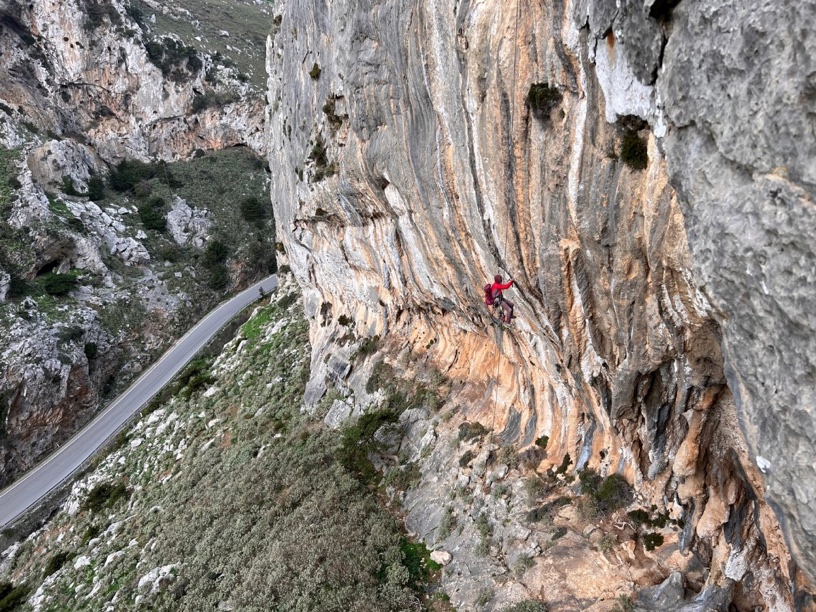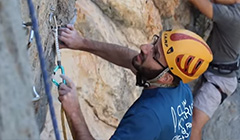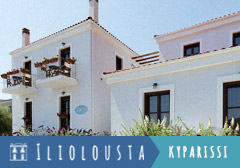



Crete, the largest and southernmost island in Greece, is home to abundant high-quality limestone and several sport crags. Select sectors in Crete were featured in both editions of our Greece Sport Climbing: The Best Of guidebook. The potential is there for more quality climbing, and a team of us here at Climb Greece did some new routing in Crete over the past few months—but we also focused on reviving some very worthwhile crags that were not being climbed for reasons we explain in each section. The focus was in the wider area of Plakias, in southern Crete, where more than 80 routes were equipped or rebolted. More specifically, the areas covered here are: Plakias (sector Paligremnos); Kotsyfou Canyon (sector Kotsifopedio); Lefkogeia (sector Gianniou); and Kria Vrisi (sectors Spiliari, Gré Dafni, Poro, and Dafnaki). Each climbing area is described in detail below, and routes are available in a free mini guide at the end of this post to download and share.

PLAKIAS AREA
Plakias is a small seaside village with an impressive beach on the south coast of Crete. It belongs to the regional unit of Rethimno, the third largest city in Crete, which is almost directly opposite, on the north coast, some 35km away. Plakias beach is sandy and long—one of the longest in southern Crete—, and this alone is reason enough for tourists to flock to the area.
But it is Paligremnos, an immaculate vertical cliff with impressive crack systems, that causes the climber’s heartbeat to quicken. The striking and perfectly smooth vertical limestone wall rises at the far end of the beach in a stunning display of geological beauty.

The job
Nearly 60 routes were equipped and/or rebolted in the wider Plakias area by a Climb Greece team. Overseeing the project was mountain guide Aris Theodoropoulos; other members of the team included Dimitris Titopoulos (mountain guide); Dimitra Klaoudatou; George Kopalides; Kostas Grafanakis; Tiia Porri; and Dimitris Diamantis. The project was made possible thanks to financial support from the Agios Vasileios municipality and accommodation by the Plakias hotel association.
Equipping and/or rebolting was carried out at three crags in and around Plakias: Plakias Beach (sector Paligremnos, Main and Upper, 31 routes); Kotsyfou Canyon (sector Kotsifopedio, 23 routes); and Lefkogeia village (sector Gianniou, six routes).
1. PLAKIAS BEACH / SECTOR PALIGREMNOS

- Paligremnos Main
The smooth large cliff at the end of the beach. An established and iconic climbing sector. The Climb Greece team rebolted one route (KOUFALA 7b) in 2021 using titanium bolts.
Climbing
On a very smooth vertical and slightly overhanging wall with assorted cracks, small tufa pipes, horizontal crimps, small jugs, and sidepulls. Paligremnos Main features 32 routes up to 45m long with grades between 6c–8a. The first routes date back to 1979.
Because of the unusual climbing style, grades can—and will—feel harder for most climbers, especially grades in the lower range. In the words of Manolis Armoutakis, a local climber, “…intermediate climbers who can redpoint around 6c may come to Plakias expecting to climb at least 10 routes. But this might prove unrealistic due to the technically demanding crack climbing. A number of routes are bouldery and cruxy, and the cruxes tend to trap humidity and feel a notch or two harder than the given grade.”


Conditions
Best for climbing in spring and autumn. Summer climbing in the shade is also possible. Plakias is not good for climbing on days with strong northerly winds.
Shade (Exposure: NW)
Until about 15:00.
Kids
Very good. The approach is minimal, and the terrain is mostly flat.
Approach (Walking time: 2 mins)
Plakias is 35km from the city of Rethimno, and almost directly south of it. Therefore, from Rethimno, drive south to Plakias. When you arrive at the seafront, drive east (left) along the coastal road to the edge of the long beach. The cliff at the end is the main sector, and it can’t be missed. Drive a bit further and park on the right-hand side past Paligremnos Studios (35.180561, 24.402740). Walk up the obvious path to the cliff.
- Paligremnos Upper
Located above the main cliff, the upper cliff also exhibits tectonic mirror-like characteristics; thanks to more and bigger features, though, it offers the possibility for easier climbing. All routes here are new, bolted by the Climb Greece team in 2021.
Climbing
On vertical or slightly overhanging short routes to the left, and longer slabby routes with good pockets to the right. Routes are well-protected, with grades ranging between 5c and 7b+. The limestone is generally sharp at the upper part but it will improve with traffic. Route names, inspired by Cretan traditions, are engraved on discreet stainless steel plaquettes and fixed on the rock.
Conditions
Best for climbing in spring and autumn. Summer climbing in the shade is also possible. Plakias is not good for climbing on days with strong northerly winds.
Shade (Exposure: NW)
Until about 15:00.
Kids
OK, with a relatively easy approach.
Approach (Walking time: 10-12 mins)
Park at the same spot as for Paligremnos Main (35.180561, 24.402740). Walk straight ahead (east) and follow the path that starts at the right of Plakias Bay Hotel. After 200m turn right onto a path that leads above the main sector. After 500m turn left and continue to the foot of the cliff straight ahead.

Important: Paligremnos under threat by new hotel construction
Sadly, a new hotel development being built above the Paligremnos cliff threatens to destroy this beloved cliff and the surrounding landscape. According to a study by the Natural History Museum of Crete, the excavation, construction, and landscaping of the hotel complex won’t just alter the character of the area, but may potentially induce land corrosion that will require further reinforcements to prevent landslides and keep the rock together. The local community is up in arms: local authorities, commercial and professional associations, the Natural History Museum of Crete, the Greek Society for the Environment and Cultural Heritage, the Rethimno architects’ association, the technical chamber, and residents of the area are all united in the effort to save Paligremnos. We stand by them and urge all climbers to join the effort to save this unique cliff. For more info please visit the public Facebook group Save Paligremnos – SOS Plakias.
2. KOTSYFOU CANYON: SECTOR KOTSIFOPEDIO

Kotsyfou Canyon (or Kotsyfou Gorge) is a 2km-long gorge only 15 minutes by car from Plakias beach. The gorge forms between the peaks Kurupa (984m) and Krioneriti (1,312m). It starts at Kanvos village and ends at Plakias.
Sector Kotsifopedio is located approximately midway through the gorge, on the left-hand side as you drive in the direction of Plakias and the sea. 15 routes were originally bolted here between 2009 and 2014 by Fabrice Molle, Stelios Kosmopoulos, Iakovos Mavroidis, and Vangelis Lavas. The limestone is solid and excellent, with an enticing middle section decorated with stalactites and tufa pipes, and grey slabs off to the side. The routes at Kotsifopedio were rarely climbed, though. The most likely reason is a combination of non-stainless-steel bolts and their placement on colonettes.



The job
The Climb Greece team replaced nearly all old bolts, most of which were corroded and dangerous. Furthermore, they enhanced the sector with eight new routes.
Climbing
Harder climbing on high-quality solid limestone with tufas, colonettes, and vertical walls. Route names are written on the rock.
Conditions
Generally good for climbing year-round. Not good on cold, rainy, or very windy days, as it is unprotected from the north.
Shade (Exposure: W)
Almost all day thanks to the shape of gorge.
Kids
Not good.
Approach (Walking time: 10-12 mins)
From Plakias village, drive in the direction of Myrthios village. From there, continue in the direction of Kanebos village. The road to Kanebos village will take you to the entrance of Kotsifou Canyon. At the beginning of the gorge, drive past the chapel of Agios Nikolaos on the left. Drive 200m further and park on the left-hand side, at the end of a barbed wire fence (35.222593, 24.400381). Cross to the other side and walk down to the stream, then uphill following the marked trail.
Attention
There are frequent rock falls at the parking area after it rains.
More info of interest
It is possible to hike along a narrow paved road in the riverbed of the gorge and enjoy magnificent views of the high vertical rock walls. Two small waterfalls at the beginning of the route are also worth checking out.
3. LEFKOGEIA VILLAGE / SECTOR GIANNIOU

Lefkogeia or Lefkogia (pronounced lef-KOYA) is a traditional village less than 7km from Plakias, close to the historic monastery of Preveli. Sector Gianniou (pronounced ya-NEW) is a slab a bit further south, just outside a small hamlet of the same name, next to an ancient water spring. (The name Lefkogeia is inspired by the white flowers that fill the fields in springtime; the village is located between streams that flow down to Ammoudi beach.)
Climbing
Slab climbing on six routes graded 5a to 6c+. Well-protected and very good for new climbers, families with kids, and climbing schools. Route names are written on the rock.
Conditions
Generally good for climbing year-round. Not good on cold or rainy winter days.
Shade (Exposure: N)
Almost all day.
Kids
Very good.
Approach (Walking time: none)
From Plakias village, drive to Lefkogeia village. As soon as you arrive, turn right following the sign to Gianniou. Drive carefully through Gianniou; the road is narrow. As you exit the village, turn left. You will come to a concrete structure enclosing the ancient spring (pictured). Park and climb the slab on the right (35.168758, 24.452645).

4. KRIA VRISI (mountain village 36km east of Plakias)
Kria Vrisi is an inland village built at the foot of Mt Kedros, in the southern Rethimno region. The village itself is built at an altitude of 480m, and it is 36km east of Plakias. Kria Vrisi means “cold water spring,” and indeed there is a spring nearby in the Gré Dafni gorge. Sector Kria Vrisi is located at the very end of the gorge, 300m higher than the village, and enjoys spectacular views over the Libyan Sea.
The job
Climbing development in Kria Vrisi started back in 2008 and has been warmly welcomed by local residents, who are keen to support ecotourism as a driver of economic growth to the area. Climbing development has been funded by the local Agios Vasilios municipality and the local organization 35 Ethnomartyres. All routes have been bolted by the Greek mountain guide Dimitris Titopoulos.

Climbing
On excellent limestone across four sub-sectors (Spiliari, Gré Dafni, Poro, and Dafnaki), providing a variety of climbing styles and features. Stalactites, vertical walls and slabs, overhangs with crimps, and small gullies are all here. The nature and scale of the cliff is also good for harder two- or three-pitch routes with the potential and room for easier multi-pitches, too. Sub-sectors Spiliari and Dafnaki have been developed with beginners and climbing schools in mind. All bolts and hangers are stainless steel, and all lower-offs are clippable. Route names are written on the rock.
Conditions
Best for climbing in spring and autumn. Climbing is also possible on summer afternoons, as well as winter days when winds blow from the south, as the sector is quite protected.
Shade (Exposure: NE)
After 14:30


Approach (Walking time: 10-20 mins)
Kria Vrisi is 36km from Plakias village, 41km from Rethimno city, 90km from Heraklion (the capital of Crete), and 14km from Spili village, the seat of the local Agios Vasileios municipality. From Plakias, drive east to Spili village (approx. 22km). From Spili, follow the signs towards Agia Galini. Then, look for the sign to Kria Vrisi. Turn left and drive 700m to the village. Pass the first two houses and turn left. Drive on a concrete road for 2.1km (it later turns into a dirt road). At the 2.1km mark, park right next to the curve (Parking 1, pictured). From there, follow the footpath that leads first to sub-sector Dafnaki, as pictured, for 15-20 mins.
Alternatively, to approach sub-sector Gré Dafni first, continue past Parking 1 and park at the next curve (Parking 2, pictured). From there, follow the footpath leading to Gré Dafni, as pictured, for 10-12 mins.
More info of interest
The local cultural association provides free accommodation at the village school building and schoolyard. For more info, please contact Mr. Yiannis Vavourakis at: +30 697 395 5720.
Kria Vrisi village has a dark history from the German occupation during WW2, when the German forces executed 35 men from the village to retaliate after the village helped Greek and British guerilla fighters.
Mt Kedros (1,776m) is a haven for rare plants, animal wildlife, and birds of prey. It is part of the Natura 2000 network of protected areas.
The gorgeous nearby beaches Agios Pavlos and Triopetra are yet another good reason to visit.























5 Comments
Markus
Hello
Great your work and dedication.
I’m going in March for 3 weeks to do some home office in Plakias.
I saw that there are different climbing spots.
Is it possible there to fix the rope on the top, means to walk up and fix the rope and then climb with a manual ascender?
I have some experience with this.
Thank you in advance for your help.
Have a nice day
Markus
Aris
Hi Markus, Yes, it is possible, just need experience to access with safety the top anchors.
Katie
Note that all routes at Plakias main sector were recently rebolted with titanium glue-in bolts, as reported by the group “Cretan Climbing Community” on their facebook page on Jan 30, 2024: https://www.facebook.com/cretan.climbing.community
Ben
I must be missing something. How does this guide work? I’m not able to determine where the climbs are. Anyone else?
Víťa
hi Aris and Kostas
Thanks for a great job done in AgioFarango
Let’s meet soon again 😉